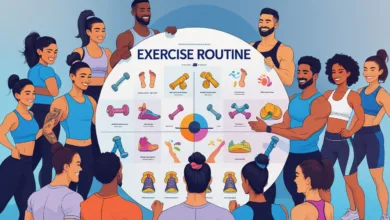Benefits of strength training for weight loss

Are you tired of trying fad diets and endless hours of cardio with little to no results? It’s time to switch up your routine and incorporate strength training into your weight loss journey. Not only does strength training help you shed unwanted pounds, but it also has numerous benefits for your overall health and well-being. From boosting your metabolism to increasing your muscle mass, strength training can help you achieve your weight loss goals in a sustainable and healthy way. In this article, we’ll explore the benefits of strength training for weight loss and why it should be an essential part of your fitness routine. So, grab your weights and let’s dive into the world of strength training!
How strength training helps with weight loss
When it comes to weight loss, most people think of cardio as the go-to exercise. However, strength training can be just as effective, if not more so, for shedding those unwanted pounds. Strength training helps you build lean muscle mass, which in turn increases your metabolism. This means that even when you’re not working out, your body will be burning more calories than it would without the added muscle. Additionally, strength training can help you maintain muscle mass while losing fat, which is important for long-term weight loss success.
But how does strength training actually help you lose weight? When you lift weights, you’re creating tiny tears in your muscle fibers. Your body then repairs these tears, which leads to an increase in muscle mass. This repair process also requires energy, which means that your body will be burning more calories even after your workout is over. Plus, the more muscle you have, the more calories you’ll burn during your workouts, as well as throughout the day.
So, if you’re looking to lose weight, don’t overlook the benefits of strength training. Incorporating lifting weights into your fitness routine can help you burn fat, build muscle, and boost your metabolism – all of which are essential for achieving your weight loss goals.
The science behind strength training and weight loss
Now that we’ve covered the basics of how strength training can help with weight loss, let’s take a closer look at the science behind it. As we mentioned earlier, strength training helps you build muscle mass, which in turn increases your metabolism. But how exactly does this process work?
When you lift weights, you’re creating microtrauma in your muscle fibers. This damage triggers a process called muscle protein synthesis, which is the process of building new muscle tissue. As your body builds new muscle tissue, it requires more energy to maintain that tissue. This means that your body will be burning more calories even when you’re not working out.
But that’s not all. Strength training also increases your body’s production of hormones like testosterone and growth hormone, which can further boost muscle protein synthesis. These hormones also help to increase your muscle mass, which in turn increases your metabolism and helps you burn more calories. Additionally, strength training can help to reduce the production of the hormone cortisol, which is known to increase belly fat storage.
Overall, the science behind strength training and weight loss is clear. By building muscle mass and boosting your metabolism, strength training can help you shed unwanted pounds and achieve your weight loss goals.
Benefits of strength training beyond weight loss
While weight loss may be the primary goal for many people who start strength training, there are numerous other benefits to this type of exercise. Here are just a few of the many benefits of strength training beyond weight loss:
Improved bone density
As we age, our bones become weaker and more prone to fractures. Strength training can help to combat this by increasing bone density, which can reduce the risk of osteoporosis and other bone-related issues.
Increased strength and power
Strength training is all about building strength and power, which can improve your overall quality of life. Whether you’re carrying groceries up a flight of stairs or participating in a sport, having increased strength and power can make everyday activities easier and more enjoyable.
Reduced risk of injury
By strengthening your muscles and improving your overall fitness, you can reduce your risk of injury. This is especially important for older adults, who may be more prone to falls and other accidents.
Better balance and coordination
Strength training can also improve your balance and coordination, which can help you perform everyday activities more effectively. This is especially important as we age, when falls and other accidents become more common.
Improved mental health
Finally, strength training has numerous benefits for your mental health. Exercise has been shown to reduce stress and anxiety, improve mood, and boost self-esteem. By incorporating strength training into your fitness routine, you can reap these mental health benefits along with the physical benefits.
Overall, the benefits of strength training go far beyond weight loss. By building strength, power, and overall fitness, you can improve your quality of life and reduce your risk of numerous health issues.
Common misconceptions about strength training and weight loss
Despite the numerous benefits of strength training for weight loss, there are still many misconceptions surrounding this type of exercise. Here are a few of the most common misconceptions about strength training and weight loss:
Myth: Strength training will make you bulky
One of the biggest misconceptions about strength training is that it will make you bulky. However, this is simply not true. While lifting heavy weights can lead to an increase in muscle mass, it takes a lot of time, effort, and dedication to achieve a bulky physique. Additionally, women have lower levels of testosterone than men, which means that they are less likely to bulk up from strength training.
Myth: Cardio is the only way to lose weight
Another common misconception is that cardio is the only way to lose weight. While cardio can certainly help you burn calories, it’s not the only way to shed unwanted pounds. Strength training can be just as effective, if not more so, for weight loss.
Myth: You have to lift heavy weights to see results
Many people believe that in order to see results from strength training, you have to lift heavy weights. However, this is not necessarily true. While lifting heavy weights can certainly help you build muscle mass, lighter weights can also be effective if you’re just starting out or if you’re looking to tone your muscles.
Myth: Strength training is only for young people
Finally, some people believe that strength training is only for young people. However, this couldn’t be further from the truth. Strength training can be beneficial for people of all ages, from teenagers to older adults. In fact, older adults may even benefit more from strength training, as it can help to combat the muscle loss that often occurs with aging.
How to incorporate strength training into your weight loss plan
If you’re ready to start incorporating strength training into your weight loss plan, here are a few things to keep in mind:
Start slow
If you’re new to strength training, it’s important to start slow and gradually increase your intensity over time. This will help you avoid injury and ensure that you’re building muscle safely and effectively.
Use proper form
Using proper form is essential for getting the most out of your strength training workouts and avoiding injury. If you’re not sure how to perform a particular exercise, consider hiring a personal trainer or watching instructional videos online.
Mix it up
To keep your workouts interesting and avoid plateaus, it’s important to mix up your strength training routine. This can include using different equipment, trying different exercises, or varying your reps and sets.
Combine strength training with other types of exercise
While strength training can be effective for weight loss on its own, combining it with other types of exercise can be even more beneficial. Consider adding in some cardio or yoga to help you achieve your weight loss goals.
Overall, incorporating strength training into your weight loss plan can be a great way to shed unwanted pounds and improve your overall health and well-being.
Best strength training exercises for weight loss
Now that you know the benefits of strength training for weight loss and how to incorporate it into your fitness routine, let’s take a closer look at some of the best strength training exercises for shedding unwanted pounds. Here are a few of our favorites:
Squats
Squats are one of the most effective strength training exercises for weight loss, as they work multiple muscle groups at once. To perform a squat, stand with your feet shoulder-width apart and lower your body as if you’re sitting back into a chair. Keep your weight in your heels and your knees behind your toes. Return to the starting position and repeat.
Lunges
Like squats, lunges work multiple muscle groups and are great for toning your legs and glutes. To perform a lunge, step forward with one foot and lower your body until your back knee is hovering just above the ground. Return to the starting position and repeat on the other side.
Deadlifts
Deadlifts are a great exercise for targeting your hamstrings and glutes. To perform a deadlift, stand with your feet hip-width apart and hold a barbell or dumbbells in front of your thighs. Hinge at your hips and lower the weight down as far as you can while keeping your back straight. Return to the starting position and repeat.
Push-ups
Push-ups are a classic exercise that work your chest, arms, and core. To perform a push-up, start in a plank position with your hands shoulder-width apart. Lower your body until your chest nearly touches the ground, then push back up to the starting position.
Pull-ups
Pull-ups are a challenging exercise that work your back, arms, and core. To perform a pull-up, grip a pull-up bar with your palms facing away from you and your hands shoulder-width apart. Pull your body up until your chin is above the bar, then lower back down to the starting position.
How to progress in your strength training routine
As you become more comfortable with strength training, it’s important to continue challenging yourself in order to see results. Here are a few tips for progressing in your strength training routine:
Increase your weight
One of the simplest ways to progress in your strength training routine is to increase the amount of weight you’re lifting. Start with a weight that challenges you but allows you to perform the exercise with proper form, then gradually increase the weight over time.
Add more reps or sets
Another way to progress in your strength training routine is to add more reps or sets to your workouts. This will help you build endurance and increase your overall strength.
Try new exercises
To keep your workouts interesting and avoid plateaus, try adding new exercises to your routine. This can include using different equipment, trying different variations of existing exercises, or incorporating new exercises altogether.
Use supersets or circuits
Supersets and circuits are great ways to challenge yourself and increase the intensity of your workouts. To perform a superset, simply perform two exercises back-to-back with little to no rest in between. To perform a circuit, perform multiple exercises in a row with little to no rest in between.







